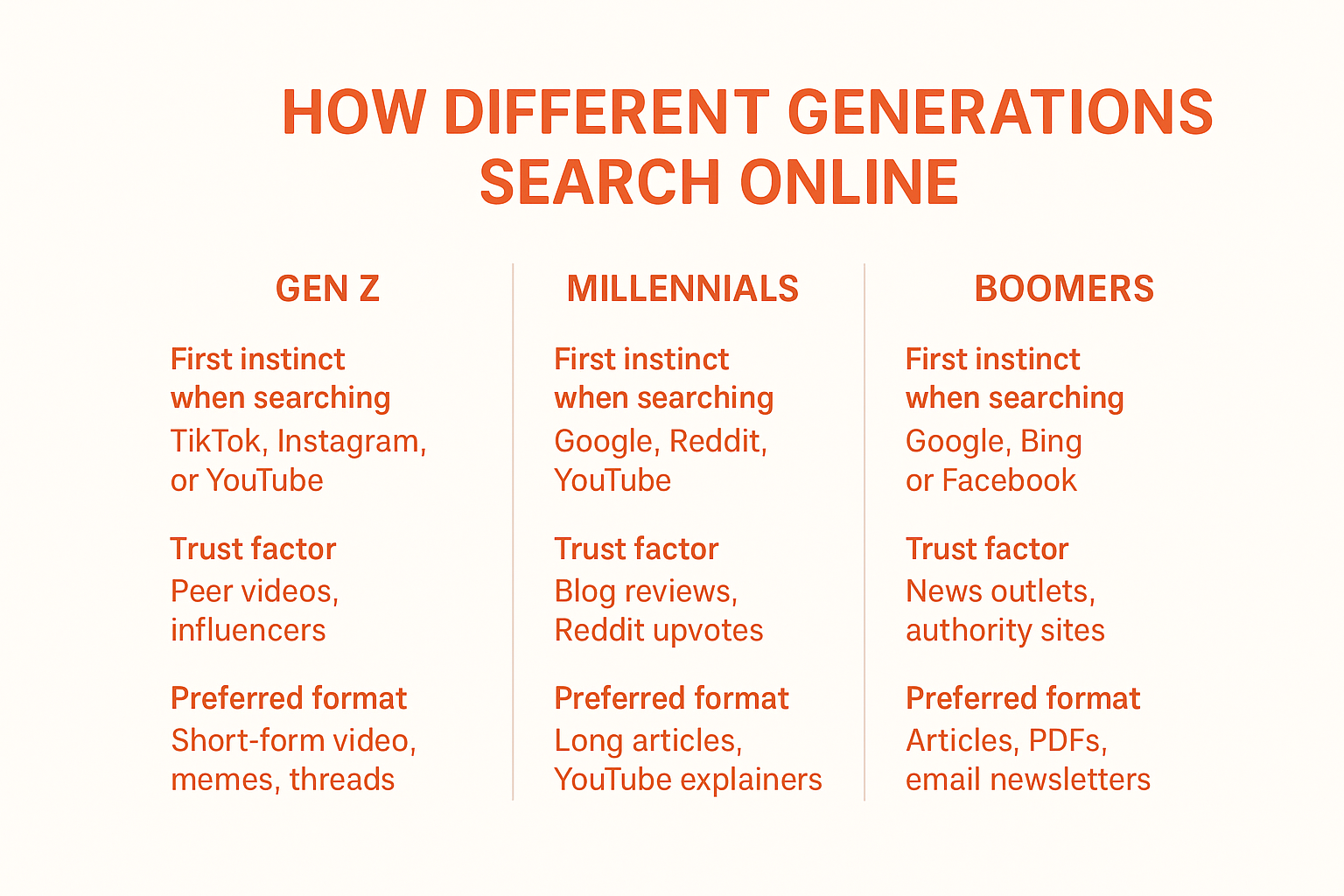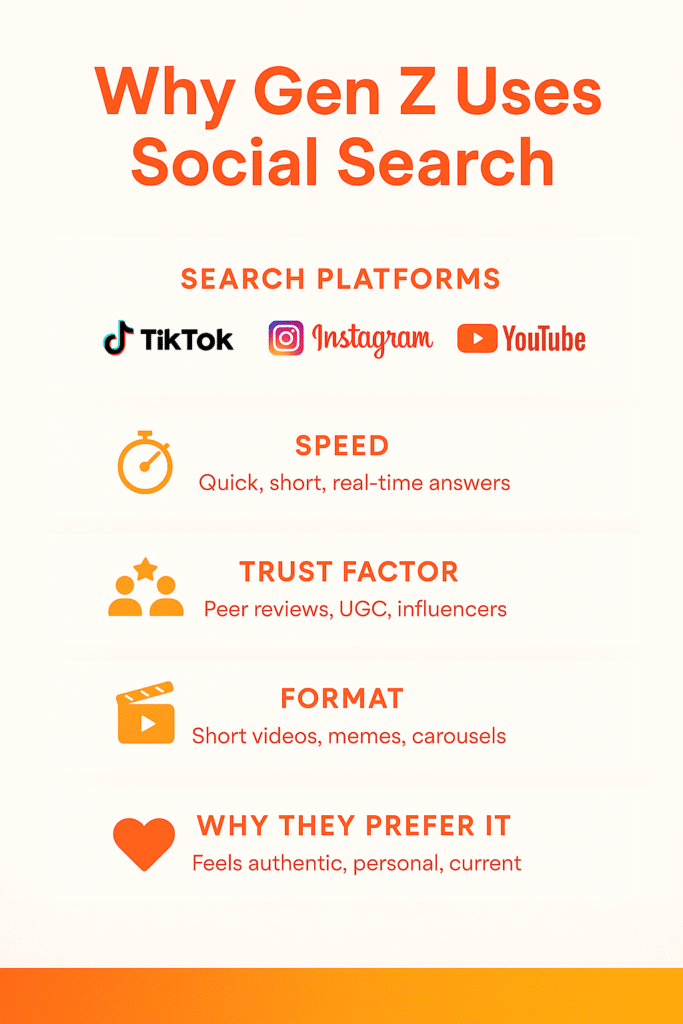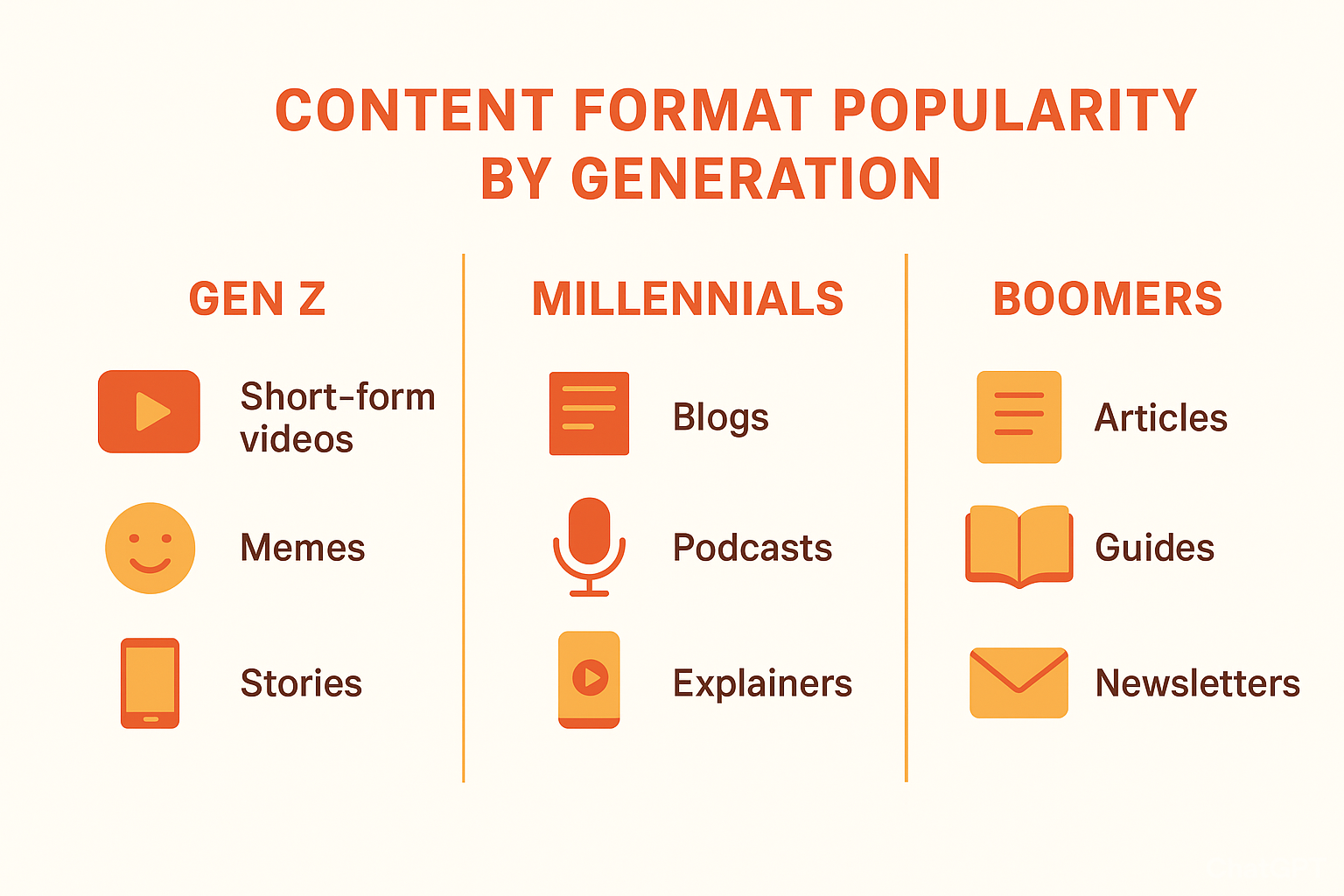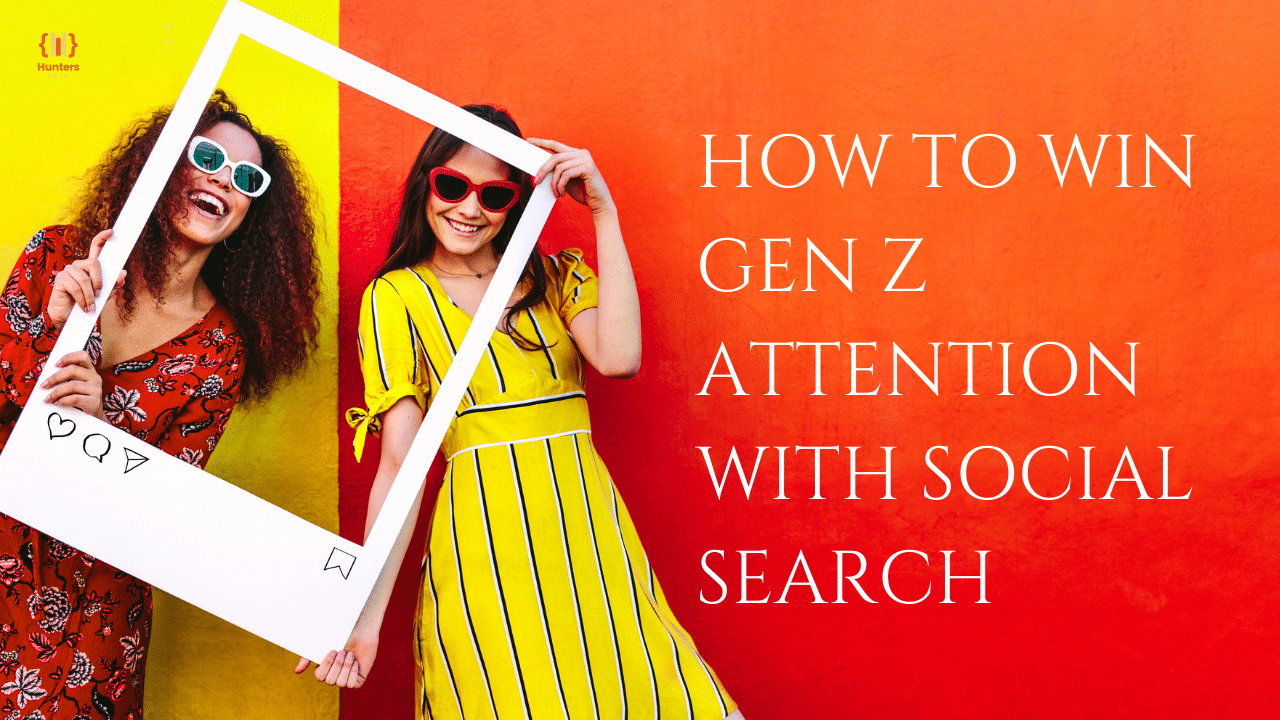Generation Z is much more than another generation of online users; they are the first generation to have grown up in an entirely digital world. This generation was born in 1997-2012, and now makes up over 30% of the global population and controls billions of dollars in spending power.
But here’s the shift: they don’t search in the same way that Millennials or Boomers search.
Rather than opening Google, they open TikTok, Instagram, YouTube Shorts, and even Reddit to get answers and engage with informational content. The cultural phenomenon is called social search, and if you are not leveraging social search, you will lose a whole generation’s attention.
In fact, a Google internal study revealed that 40% of Gen Z prefer TikTok or Instagram for search over Google.
So, the real question is: How do you win Gen Z attention with social search?
Why is Gen Z obsessed with social search?
Because efficiency beats volume.
Gen Z doesn’t want to scroll 10 blue links on Google; they want direct answers, visuals, and peer validation. TikTok, Instagram, and YouTube give them that in seconds.
- 53% of Gen Z use TikTok or Instagram as their first search tool.
- They prefer authentic short-form content over blog posts or Wikipedia-like pages.
- They ask: “Where’s the best sushi near me?” — and expect a video review, not a text directory.
If you’re not optimizing for social search, you’re invisible to the next generation of consumers.
What is social search in simple terms?
Social search = finding answers, products, or recommendations through social media instead of traditional search engines.
Examples:
- Searching “affordable vintage jackets” on TikTok instead of Google.
- Looking up “best productivity apps” on YouTube to watch reviews.
- Using Instagram hashtags (#singaporefoodie) to discover restaurants.
Why it works:
- Feels human → answers come from peers, not algorithms.
- Feels visual → videos/images show the product in real life.
- Feels trustworthy → reviews look authentic, not staged.
How do you grab Gen Z’s attention with social search?
Here’s the direct answer upfront:
- Be authentic over polished.
- Deliver answers in under 30 seconds.
- Use visual-first storytelling (short videos, carousels, memes).
- Encourage community interaction (comments, duets, remixes).
- Make your content searchable on social media (captions, hashtags, and keywords within your speech).
Now let’s break it down with examples, comparisons, and strategies.
How does Gen Z actually search online?

Here’s a side-by-side view of Gen Z vs Millennials vs Boomers.
| Group | First instinct when searching | Trust factor | Preferred format |
| Gen Z | TikTok, Instagram, YouTube | Peer videos, influencers | Short-form video, memes, threads |
| Millennials | Google, Reddit, YouTube | Blog reviews, Reddit upvotes | Long articles, YouTube explainers |
| Boomers | Google, Bing, Facebook | News outlets, authority sites | Articles, PDFs, email newsletters |
Key insight: Gen Z skips the “10 blue links.” They want visual answers + social proof.
How can brands show up in social search?
Winning Gen Z attention means showing up where they search—and speaking their language. Here’s the direct playbook before we go deeper:
- Be searchable on TikTok, YouTube, and Instagram.
- Use trending keywords + hashtags as search hooks.
- Turn FAQs into snackable videos.
- Leverage UGC (user-generated content).
- Prioritize authenticity over polish.
What type of content wins Gen Z attention?
Instead of guessing, look at what actually shows up in TikTok’s search results.
Gen Z prefers:
- “How-to” explainer clips (30–60 sec)
- Street interviews (“What’s your favorite budget phone?”)
- Unboxing / reviews
- Day-in-the-life vlogs (“$20 a day in NYC”)
- Duet reactions (reacting to trending topics)
Gen Z ignores:
- Overly polished corporate ads
- Walls of text with no visuals
- SEO keyword stuffing
Example: Same search, different results
Let’s compare a simple search: “Best coffee shop Singapore.”
| Platform | What you see first | Why Gen Z likes it |
| Map pack, TripAdvisor, Yelp reviews | Too text-heavy, lacks vibes | |
| TikTok | Quick café tours, latte art videos, cost breakdowns | Visual + peer-driven |
| Hashtag feed (#sgcafe, #sgcoffee) with reels | Fits aesthetic hunting | |
| YouTube | 5-minute vlog of café hopping | Deep dive, storytelling |
Generation Z chooses TikTok/Instagram first, then maybe YouTube for longer content.
Why Gen Z Uses Social Search

Generation Z has reshaped how online discovery works. Instead of typing into Google and scrolling through endless links, they head straight to TikTok, Instagram, and YouTube for answers. Here’s why:
1. Search Platforms They Trust
Gen Z’s go-to search engines aren’t search engines at all — they’re TikTok, Instagram, and YouTube. These platforms deliver real-time answers in a way that feels native to their lifestyle.
2. Speed
This generation values quick, short, real-time answers. They don’t want to read long articles — they want to watch a 30-second clip that shows them exactly what they need.
3. Trust Factor
For Gen Z, credibility doesn’t come from authority sites — it comes from peer reviews, UGC, and influencers. A recommendation from someone relatable feels more genuine than a polished brand ad.
4. Format
Gen Z thrives on short videos, memes, and carousels. These formats are snackable, engaging, and easy to share — making them perfect for how this generation consumes information.
5. Why They Prefer It
Ultimately, Generation Z chooses social search because it feels authentic, personal, and current. They want answers that come with context, personality, and real-world proof, not just a wall of text.
If you want to reach This generation, you can’t just optimize for Google anymore. You need to show up where they’re searching — on TikTok, Instagram, and YouTube — with content that’s fast, visual, and authentic.
How do you optimize for social search?
If Google SEO is about keywords and backlinks, then Social SEO is about conversation and discoverability. To win Gen Z attention, your goal isn’t to just show up—it’s to show up first when they search inside TikTok, YouTube, or Instagram. Here’s the step-by-step process:
1. Start with Gen Z’s actual search phrases
Open TikTok’s search bar, start typing “best laptop for…” and notice what appears in the autocomplete. You’ll see real queries like “best laptop for students 2025” and “best budget laptop for editing,” among others. That’s real-time, unfiltered data from your target audience.
- Use TikTok Search → Type half a query, see autocomplete.
- Example: “Best laptop for…” → autocomplete shows students, gaming, under $1000.
2. Turn those into content hooks
Instead of a boring headline, make it sound like a friend’s recommendation:
→ “Stop wasting money — here are the best laptops under $1000 for students.”
This kind of phrasing triggers curiosity and matches how Gen Z actually searches.
- Post a short video: “Best laptops under $1000 for students (2025)”
- Add hashtags: #GenZTech #StudyTok #BudgetLaptop
3. Use captions as mini SEO
TikTok and Instagram now index captions, meaning they scan your words to decide where to rank your content. Keep captions conversational but keyword-rich.
Example: “Looking for a laptop that won’t die during lectures? I tested 3 budget ones under $1000 — here’s the winner #StudyTok #BudgetLaptop”
4. Encourage engagement loops
The more people comment, the higher your post ranks. Ask questions like: “Tag your broke college roommate who needs this!” or “What’s your dream setup?”
Engagement = visibility. The algorithm rewards interaction.
- Add call-to-action: “Tag your broke college roommate.”
- Engagement boosts search ranking.
What content formats work best in social search?

When it comes to social search, snackable, visual, and authentic content formats perform the best. Gen Z doesn’t want long-winded explanations—they want quick, engaging answers that feel real.
Short-form video
Let’s be honest — video is the universal language of Gen Z. They scroll through hundreds a day but only stop for the ones that feel personal, fast, and fun.
Short-form platforms like TikTok, Instagram Reels, and YouTube Shorts dominate because they deliver high-impact storytelling in under 60 seconds.
Some winning styles include:
- POVs (Point of View) — “Here’s how I studied for 8 hours without losing my mind.”
- Listicles — “3 study apps you didn’t know existed.”
- Mini reviews — “Testing the viral productivity app so you don’t have to.”
- Tutorials — “How to edit photos like an influencer — no Photoshop needed.”
What makes these formats shine? They’re quick, relatable, and searchable. The more people watch to the end, the higher TikTok ranks you on the FYP (For You Page).
- TikTok (POVs, quick how-tos, listicles).
- Instagram Reels (lifestyle, trends, tutorials).
- YouTube Shorts (mini reviews, hacks).
Carousel posts
Carousels aren’t dead — in fact, they’re thriving on Instagram because they encourage saves and shares. Each slide functions like a microblog post.
For example:
Slide 1: Hook — “Stop losing followers because of these mistakes.”
Slides 2–5: Actionable tips.
Final Slide: CTA — “Save this post to fix your profile later.”
Carousels perform exceptionally well for educational, motivational, and storytelling content. They’re also highly shareable — and that’s gold for social search.
Meme-style posts
Memes are Gen Z’s native language. They use humor to communicate ideas faster than any paragraph could.
A simple split-screen meme saying,
“Google results: 10 ads before the answer.”
“TikTok results: actual human explaining in 30 seconds.”
— gets shared like wildfire because it’s relatable and visual.
- Humor = retention.
- Example: Split-screen meme: “Google results with 10 ads” vs. “TikTok answer in 30 sec.”
Live content
Meanwhile, live sessions (like Q&As, AMAs, or casual demos) build real-time trust. They give audiences a chance to ask, interact, and feel connected — something Gen Z values above anything else.Remember: authenticity beats production. You don’t need fancy lighting; you need real conversations.
- Q&A sessions, product demos, AMAs.
- Works well for building real-time trust.
What mistakes should brands avoid?
Brands often miss Gen Z’s attention by repeating common mistakes:
- Posting like it’s 2010.
- No, Gen Z is reading your 1,000-word caption.
- No, Gen Z is reading your 1,000-word caption.
- Ignoring comments.
- Replies = ranking signals.
- Replies = ranking signals.
- Overly polished ads.
- Looks fake → Gen Z scrolls.
- Looks fake → Gen Z scrolls.
- Not linking to purchase.
- Gen Z wants instant action (Shop now, DM link).
- Gen Z wants instant action (Shop now, DM link).
Tip: If your content isn’t share-worthy, it won’t win Gen Z’s attention.
How Social Proof Influences Gen Z’s Buying Decisions
For Gen Z, social proof is everything. They don’t trust traditional ads. Instead, they ask: What are other people saying about this?
1. Reviews and Comments
- Gen Z checks the comment section before buying.
- A TikTok video with thousands of positive comments = instant credibility.
2. Peer Recommendations
- They trust friends and influencers more than brands.
- 92% of Gen Z says they trust peer reviews over official marketing claims.
3. UGC as Currency
- A product review from a real customer = free advertisement.
- Brands that share customer videos/photos feel more authentic.
4. Shares and Saves
- If a post gets shared a lot, it signals value.
- Gen Z often saves posts as shopping inspiration.
Takeaway: Social proof isn’t optional—it’s the backbone of Gen Z marketing.
Mistakes Brands Make When Targeting Gen Z
Here’s the harsh truth: most brands fail with Gen Z because they approach them with outdated strategies. Let’s look at the most common mistakes:
1. Being Too Corporate
- Gen Z hates jargon and overly formal tones.
- Talk like a friend, not a press release.
2. Ignoring Trends
- If you’re not tapping into trending memes, songs, or formats, you’re invisible.
- Waiting too long kills the moment—Gen Z moves fast.
3. Selling Too Hard
- Gen Z scrolls past anything that feels like an ad.
- They want entertainment first, product second.
4. Not Engaging Back
- Posting and ghosting don’t work.
- Gen Z expects comments, replies, and interactions.
5. Overproduction
- Too much polish feels fake.
- Simpler, raw videos often perform better.
Tip for Brands: If your content wouldn’t make someone send it to a friend, it probably won’t work with Gen Z.
How AI and Algorithms Shape Gen Z Social Search
Gen Z’s search results aren’t random—they’re powered by algorithms and AI. This is where things get interesting for brands.
1. Personalized Feeds
- TikTok’s “For You Page” (FYP) is entirely AI-driven.
- The algorithm learns what users like and surfaces content instantly.
- For marketers, this means content must be engaging within seconds to avoid being swiped away.
2. AI in Ranking Social Content
- Hashtags, captions, watch time, and engagement rates all influence ranking.
- The more people interact with your content, the higher it appears in social search.
3. Opportunities for Brands
- Use AI tools to track trending hashtags.
- Analyze competitor strategies with social listening tools.
- Repurpose content in multiple formats (video, reels, shorts) to maximize reach.
If you want to win Gen Z, you have to play the algorithm game. Authenticity plus optimization equals visibility.
How to Track Success in Gen Z Social Search Campaigns
It’s one thing to create content; it’s another to measure if it’s actually working with Gen Z. Traditional metrics like impressions and clicks don’t tell the full story here.
1. Key Metrics That Matter
- Saves → Shows people want to revisit your content.
- Shares → Proof your content is worth spreading.
- Comments → Engagement beats passive viewing.
- Completion Rate → Did they watch the whole video?
2. Why Views Aren’t Everything
- A viral video with 1M views but no comments ≠ success.
- A video with 50k views but 10k saves = powerful long-term value.
3. Tools for Tracking
- TikTok Analytics → Engagement rates.
- Instagram Insights → Saves, shares, and reach.
- TikTok Creative Center → Trending keywords.
- Google Trends → Compare TikTok vs Google searches.
- AnswerThePublic → See how real people ask questions.
- Brandwatch / Sprout Social → Track mentions
Don’t just measure vanity metrics. Focus on community-driven signals like shares, saves, and authentic comments. That’s where the real Gen Z impact lies.
Tips to grab Gen Z attention in under 5 seconds
- Start videos with “Here’s what no one tells you about…”
- Use captions + text overlay (they watch on mute).
- Jump cuts > slow intros.
- Show faces, not stock graphics.
Quick comparison: SEO vs Social Search
| Factor | SEO (Google) | Social Search (TikTok/Instagram) |
| Content style | Long-form, blogs | Short-form, video-first |
| Discovery | Keywords, backlinks | Hashtags, trends, UGC |
| Trust signal | Domain authority | Peer reviews, influencer trust |
| Speed | Weeks to rank | Hours to trend |
What’s next for social search?
The future isn’t just social—it’s AI + social + search combined.
- TikTok is rolling out AI-powered Q&A features.
- Google is testing TikTok and Reddit results inside search.
- Voice queries like “Show me cool thrift shops near me” will dominate.
- Communities (Discord, Reddit) will merge with discovery.
If you’re invisible on TikTok or Instagram today, you may be invisible to Gen Z altogether within a year.
Conclusion
Gen Z doesn’t want more content—they want efficient, authentic, community-driven answers. If you adapt your strategy to how they actually search, you’ll win their trust, loyalty, and attention.
To win Gen Z attention, brands must:
- Embrace video-first content.
- Prioritize authenticity over polish.
- Keywords should sound natural, not forced.
- Measure success by engagement, not vanity metrics
Your next move? Audit your content. Search your own brand on TikTok or Instagram. If Gen Z can’t find you there, you don’t exist to them.
Ready to position your brand where Gen Z is searching? Contact us today, and let’s build a social search strategy that makes your brand impossible to ignore.
FAQs
TikTok, Instagram, YouTube, and Reddit are the most influential for Gen Z’s search behavior.
By posting consistent, authentic content and encouraging customer-generated reviews.
Traditional search ranks pages with keywords and links. Social search ranks results through peer recommendations, influencers, and social signals like likes and shares.
Not at all—but it needs to be combined with social-first SEO strategies to capture Gen Z.
Expect more social commerce, AI-driven personalization, and immersive AR/VR experiences.

